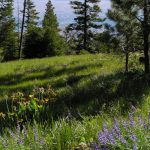How preserving wildlife habitat helped Chelan fruit growers
At the end of October, the RCO finalized the list of more than 200 proposed projects for the Washington Wildlife and Recreation Program (WWRP), and budget considerations are rapidly approaching. Increased funding for the program would build on the success of 1,200 projects that have been realized since 1990.
One such project that continues to be a model for communities across the state is the Stemilt Basin, which utilized a matching grant from WWRP to secure over 4,000 acres of mixed conifer forests and wildlife habitat in southeastern Chelan County.
The central idea of the project was to secure critical habitat with major opportunities for outdoor enthusiasts. Benefits to recreationists include access for hiking, hunting, fishing, equestrian use, backcountry skiing, snowshoeing and even snowmobiling.
The basin also provides a substantial clean water supply to many small family orchardists in the surrounding area, a resource that was threatened in the not-so-distant past.
Last November, conservationists, sportsmen and local orchardists rallied to speak out against the leasing of public lands within the Stemilt Basin that would have fenced off four parcels.
Valley residents were concerned that leasing the lands would undo years of work to establish a Stemilt Partnership, a coalition of local agriculture, wildlife, recreation, and conservation interests which was formalized in 2007. Lands in the Stemilt were intended to be conserved to protect the area’s water supply, in addition to its valuable wildlife habitat and increased recreation access.
Private leasing of these lands could have threatened water security for small family orchardists in the area.
Fortunately, matching funds from WWRP allowed Chelan County to protect a swath of land within the Stemilt Basin.
The fight to protect these lands was years in the making, and WWRP was able to fill in the funding gap, as it has done for dozens of other communities since its inception nearly 25 years ago.
In order to create more successes like these, the Washington Wildlife and Recreation Coalition is calling for $97 million in the state capital construction budget (less than 1% of the projected overall budget).
For recreationists who don their ski goggles and parkas to enjoy this area each winter and the local fruit growers in the valley below, it’s unimaginable to lose this area.
We need our legislators to take advantage of this opportunity and support robust WWRP funding for the sake of many more successes like this one that will benefit Washingtonians for generations to come.
Photo courtesy of the RCO.

